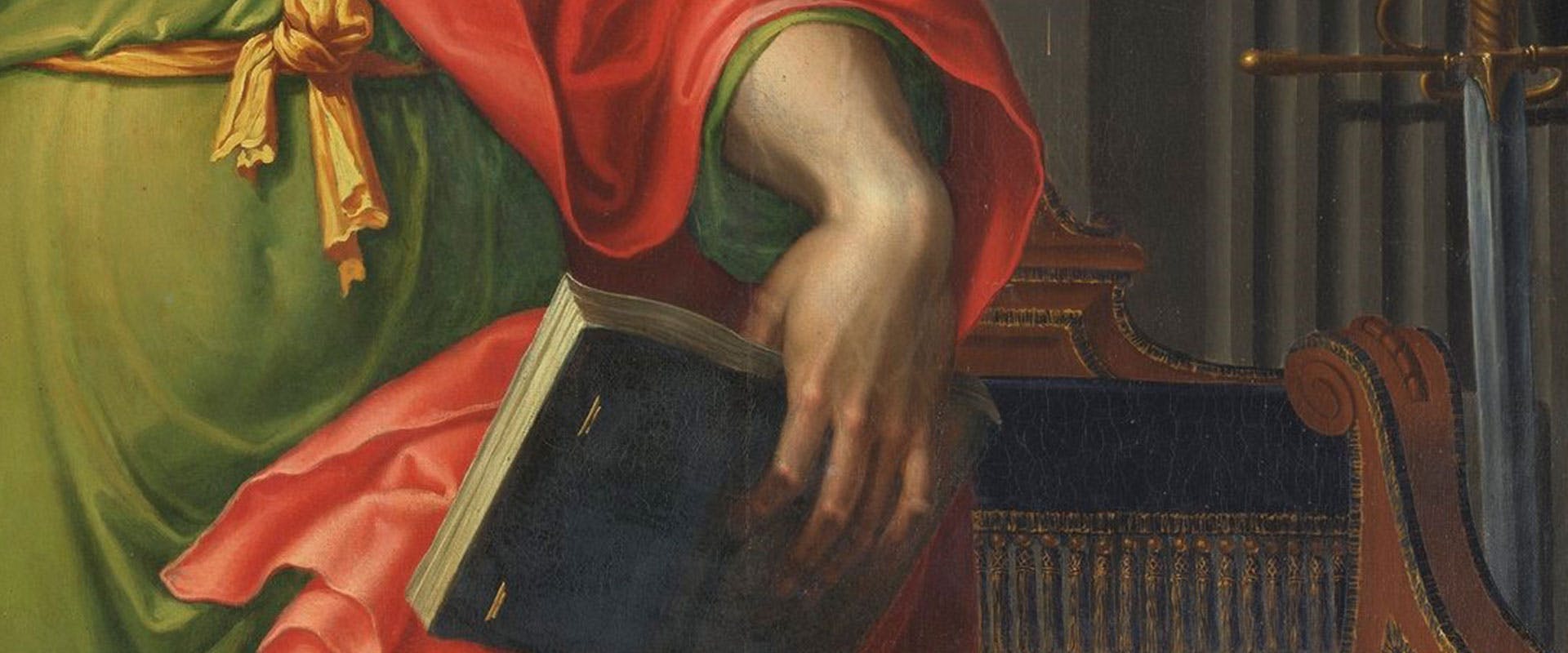An important acquisition for the Uffizi: the altarpiece for the Borromeo Chapel in Santa Maria delle Grazie in Milan
The canvas, sold at auction, was about to leave Italy
An important acquisition for the Uffizi: the altarpiece for the Borromeo Chapel in Santa Maria delle Grazie in Milan
A large painting depicting Saint Paul becomes part of the Uffizi Galleries’ collection. It is a documented work by Pellegrino Tibaldi (1527 or 1530/1531 - 1596) – one of the greatest and most versatile artists of the XVI century, active in Italy and Spain – and of his Milanese pupil Giovanni Pietro Gnocchi (1553 c. - 1609). The canvas was painted by Gnocchi with the supervision of Tibaldi and depicts full figure of Saint Paul, with an monumental architectural background and a desk beside him, at the base of which is inscribed the date 1585. The saint, with a long beard and red and green garments, can be recognized thanks to its traditional attribute, a sword, leaning against the wall. The work will be soon displayed on the first floor of the museum, in the rooms dedicated to the 16th century, inserting in the polyphony of voices of the paintings of the Counter-Reformation in Italy.
The story that has led to the acquisition of the Saint Paul by the Uffizi Galleries is quite peculiar. Sold at auction in recent months to a private individual with unreliable attribution to the Flemish painter Pietro Candido (1548 c. - 1628), the painting was about to leave Italy. However, it was detained by the Export Department of the Superintendence of Genoa upon request of the Uffizi Galleries, and purchased by the Directorate General Archaeology, Fine Arts and Landscape through the right of preemption for the Florentine museum.
It is thanks to a young scholar, Agostino Allegri, that the historical background of the painting has been reconstructed. Alessandro Bagnoli first recognized Tibaldi’s features in the work, identifying it with the Saint Paul attested by the sources in the Borromeo Chapel of the Dominican church of Santa Maria delle Grazie in Milan. In the same year indicated on the canvas, 1585, in fact, the heirs of St. Charles Borromeo, among them the young Federico, concluded an agreement with Giovanni Pietro Gnocchi, who was given the task to decorate the family chapel within one year. The artist was also commissioned an alterpiece depicting Saint Paul, following the sketch made by Pellegrino Tibaldi, who had enjoyed the unconditional favour of St. Charles Borromeo for twenty years and in 1575 was asked to rethink the architecture of this space.
A large painting depicting Saint Paul becomes part of the Uffizi Galleries’ collection. It is a documented work by Pellegrino Tibaldi (1527 or 1530/1531 - 1596) – one of the greatest and most versatile artists of the XVI century, active in Italy and Spain – and of his Milanese pupil Giovanni Pietro Gnocchi (1553 c. - 1609). The canvas was painted by Gnocchi with the supervision of Tibaldi and depicts full figure of Saint Paul, with an monumental architectural background and a desk beside him, at the base of which is inscribed the date 1585. The saint, with a long beard and red and green garments, can be recognized thanks to its traditional attribute, a sword, leaning against the wall. The work will be soon displayed on the first floor of the museum, in the rooms dedicated to the XVI century, inserting in the polyphony of voices of the paintings of the Counter-Reformation in Italy.
The story that has led to the acquisition of the Saint Paul by the Uffizi Galleries is quite peculiar. Sold at auction in recent months to a private individual with unreliable attribution to the Flemish painter Pietro Candido (1548 c. - 1628), the painting was about to leave Italy. However, it was detained by the Export Department of the Superintendence of Genoa upon request of the Uffizi Galleries, and purchased by the Directorate General Archaeology, Fine Arts and Landscape through the right of preemption for the Florentine museum.
It is thanks to a young scholar, Agostino Allegri, that the historical background of the painting has been reconstructed. Alessandro Bagnoli first recognized Tibaldi’s features in the work, identifying it with the Saint Paul attested by the sources in the Borromeo Chapel of the Dominican church of Santa Maria delle Grazie in Milan. In the same year indicated on the canvas, 1585, in fact, the heirs of St. Charles Borromeo, among them the young Federico, concluded an agreement with Giovanni Pietro Gnocchi, who was given the task to decorate the family chapel within one year. The artist was also commissioned an alterpiece depicting Saint Paul, following the sketch made by Pellegrino Tibaldi, who had enjoyed the unconditional favour of St. Charles Borromeo for twenty years and in 1575 was asked to rethink the architecture of this space.
